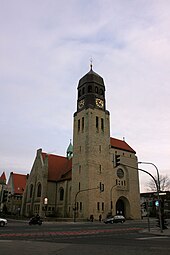Luther Church (Osnabrück)
The Luther Church is an Evangelical Lutheran church in the Neustadt of Osnabrück (Lower Saxony). It was built from 1907 to 1909 by the architect Karl Börgemann based on the Wiesbaden program in the arched style. Their specialty is the ornamental Art Nouveau painting.
history
The Evangelical Lutheran parish of St. Katharinen in the old town of Osnabrück had grown to almost 15,000 believers at the beginning of the 20th century. The church council decided to build another church in the new town. In 1903, the community bought a plot of land on Iburger Strasse in today's Schölerberg district from the monastery chamber for 7,500 marks . The architect Karl Börgemann in Hanover was awarded the contract for the construction . However, its design has been simplified for cost reasons.
Construction began on September 23, 1907; on November 14, 1909, the church was consecrated as a daughter congregation of St. Katharinen. The first pastor of the Luther Church was Hugo Blitz. In 1912 the rectory was built on Miquelstrasse. The Luther Church congregation gained its independence in 1927. During World War II , in which large areas of the city were destroyed, the church suffered minor damage apart from the destruction of the windows. However, cracks appeared in the masonry in the 1970s, which had been caused by layers of bog in the subsoil.
The masonry was renovated between 1985 and 1989. The Art Nouveau painting, which was covered with a white paint in emulsion paint in the 1950s, was restored by the Bremen restorer Klaus Thönes and his colleagues. The windows were newly created in 1949 and 1993 by the Deppen & Söhne glass workshop from Osnabrück. A new parish and parish house was built in 1964 on Iburger Strasse.
The church bells were renewed twice; for the first time in 1926, after the bells from the founding period had been melted down during World War I. Except for the smallest bell, these bells were also lost in the Second World War. The four bells now available were cast by the Bochum Association and consecrated on March 22, 1957.
The organ from 1967 by Emil Hammer Orgelbau from Hanover replaced the first one from the early days , which was built by Rohlfing from Osnabrück.
Church building
The church made of shell limestone from the region has a basilica Romanesque floor plan with a round apse to the east. The sacristy is attached to it. The nave is extended to the north. The aisle is separated by a sliding glass door. The tower on the northwest side of the westwork has a square floor plan and a tower dome covered with copper plates.
The altar, the pulpit and the baptismal font were also made of shell limestone. The baptismal font has a bronze bowl with a Luther rose .
Art Nouveau painting
The ceiling and wall paintings of the Luther Church were created in 1908 by twelve Protestant master painters from Osnabrück Neustadt under the direction of the master painter Lotz. These are cofferings with floral ornaments, diamond paintings and accompanying ribbons, for example on the belt arches of the barrel vault. Cassette painting can also be found on the decorative ribbon of the choir apse. The lower plinth area bears a lambris painting.
The Hanoverian painter Hermann Schaper created a picture of Christ for the choir apse .
literature
- Günter Hindersmann: The Art Nouveau in Osnabrück. In: Heimat-Jahrbuch for the Osnabrücker Land. Meinders & Elstermann, Osnabrück 2002, ZDB -ID 1226420-9 .
- Ingeborg Hagedorn: Luther Church Osnabrück. (= Small Art Guide , No. 2118.) Schnell & Steiner, Regensburg 1994.
Web links
Coordinates: 52 ° 15 '38 " N , 8 ° 3' 25" E

